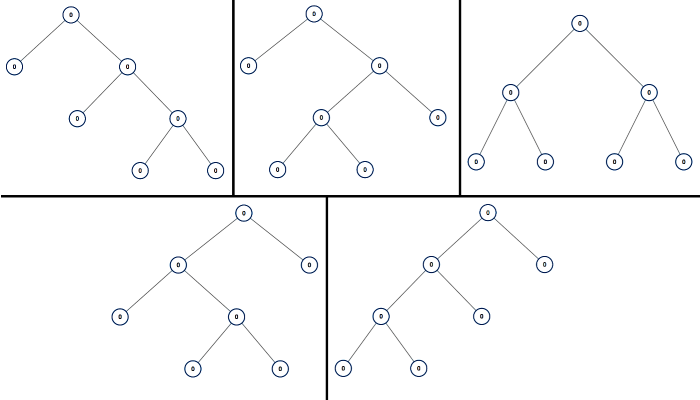满二叉树是一类二叉树,其中每个结点恰好有 0 或 2 个子结点。
返回包含 N 个结点的所有可能满二叉树的列表。 答案的每个元素都是一个可能树的根结点。
答案中每个树的每个结点都必须有 node.val=0。
你可以按任何顺序返回树的最终列表。
示例:
输入:7
输出:[[0,0,0,null,null,0,0,null,null,0,0],[0,0,0,null,null,0,0,0,0],[0,0,0,0,0,0,0],[0,0,0,0,0,null,null,null,null,0,0],[0,0,0,0,0,null,null,0,0]]
解释:

提示:
1 <= N <= 20
code:把结点总数拆分为:左、根、右进行递归。如7可以拆为1(左)、1(根)、5(右),此时5又可以拆为左(1)、根(1)、右(3),无论怎样拆,都要保证根节点数是1既可。
/** * Definition for a binary tree node. * struct TreeNode { * int val; * TreeNode *left; * TreeNode *right; * TreeNode(int x) : val(x), left(NULL), right(NULL) {} * }; */ class Solution { private: unordered_map<int,vector<TreeNode*>> hash;//1.作为缓存优化 public: vector<TreeNode*> allPossibleFBT(int N) { if(N<=0||N&1==0)//2.偶数无法组成满二叉树 return {}; vector<TreeNode*> res; if(N==1) { TreeNode* head=new TreeNode(0); res.push_back(head); return res; } for(int i=1;i<N;i+=2)//3.每次加2,因为要跳过根节点 { vector<TreeNode*> left; unordered_map<int,vector<TreeNode*>>::iterator pos=hash.find(i); if(pos==hash.end()) { left=allPossibleFBT(i);//4.左子树中结点的个数 hash.insert({i,left}); } else left=hash[i]; vector<TreeNode*> right; pos=hash.find(N-i-1); if(pos==hash.end()) { right=allPossibleFBT(N-i-1);//5.右子树中结点的个数,减去根节点 hash.insert({N-1-i,right}); } else right=hash[N-i-1]; for(auto l:left) { for(auto r:right) { TreeNode* head=new TreeNode(0); head->left=l; head->right=r; res.push_back(head); } } } return res; } };